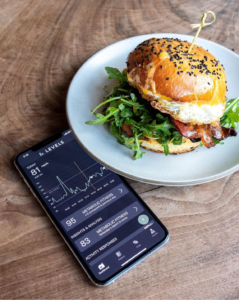3 Ways Keeping Blood Sugar Stable Can Improve Productivity and Health By Alex Moskov
Fact Checked by Casey Means, MD
You know that feeling you get after you eat a big, delicious meal? Most of us just write off that groggy haze as something that “just happens,” but it’s actually fascinating when you dive under the hood.
The infamous “post-meal slump” is usually people’s most intimate interaction with how blood sugar levels can impact us. So, while that gluten-free, grain-free, paleo banana bread might be delicious — and frankly, is making us hungry as we write this — it’s very important to understand how it impacts our blood sugar (also known as glucose) levels. The interesting thing is that a yummy treat like this is likely to affect everyone’s glucose levels differently, based on our body’s unique and personalized response to food.
Keeping Your Blood Sugar Stable
Whatever the case, if your glucose levels are out of a fairly narrow range, you might just feel off. Despite glucose being a key molecule in the body associated with energy, many of us don’t track it closely, and may not have a clear idea what it feels like to have very stable glucose.
If your glucose levels are erratic, you can experience sharp spikes and crashes in energy and lose focus, and if this happens over the long term, it can potentially put you at risk for a wide variety of health conditions.
In this article, we’re going to demystify glucose levels for the healthy person, and why stabilizing glucose levels in a healthy range can benefit your life in 3 major ways.
1. Boost Mental Clarity
Could tracking our glucose levels be a clue to making us more focused, clear-headed, and mentally sharp? Research suggests yes.
In one study, researchers gave healthy participants a drink loaded with glucose and then tracked their blood glucose levels. Based on the results, participants were categorized into three groups: “better glucose regulators,” “average glucose regulators,” and “worse glucose regulators.”
The “worse glucose regulators” had higher post-drink glucose peaks and were slower to get their glucose levels back down to their pre-meal levels. This group also did the poorest on a variety of verbal memory tests, such as assessments for performance on word list recall, word order recall, and paragraph recall.
The Connection Between Cognitive Function & Blood Sugar Levels

This makes sense: your brain primarily relies on glucose for energy, and glucose level irregularity is known to be linked with decreased energy levels, feelings of fatigue, and reduced alertness. This tricky trio culminates in a lack of overall mental clarity.
Keeping Blood Sugar Stable Post-Meal
If you encounter a “post-meal slump,” it’s possible that a part of that feeling is from how your glucose levels are responding to your meal. How might you avoid this? The first is to be more mindful of what you’re eating and how it’s making you feel. To gain more clarity, testing glucose is also an option: by tracking glucose levels before and after meals, you can gain real data into the impact of particular foods on glucose levels, allowing you to create your own “personalized glycemic index” scale, and start correlating whether the foods that have the most impact on glucose are the same ones zapping mental clarity.
2. Increase Natural Energy Levels
Your brain not only needs glucose to function properly, but it also needs glucose processing pathways to be sharp and efficient. You can think of the brain as a complex and sensitive part of the body that wants glucose “just so.”
Many studies note that individuals with difficulty maintaining glycemic control suffer from notable fatigue and low energy levels compared to healthy populations. These symptoms may be related to the immediate effects of sharp dips and spikes in glucose levels, as well as longer-term changes in the brain from chronically dysregulated glucose levels.
Swings In Blood Sugar Levels
High glycemic variability, a term that refers to the amount of up and down swings in glucose throughout a day, is a verified trigger of oxidative stress, a damaging process in which cellular dysfunction-causing “free radicals” are formed. The brain is very sensitive to oxidative stress, and this process has been linked to chronic fatigue.
Given that the typical Western diets are filled with refined grains and sugar — foods that notoriously spike glucose — it’s possible that your glucose may be swinging up and down for much of the day, and the energy crashes you’ve gotten used to could be caused by your diet. Tracking glucose levels more closely can help us zero in on whether glucose is a variable in our energy levels. The beauty is that our propensity to have glucose spikes is easily modifiable with smart dietary and lifestyle tweaks.
3. Lowering the Risk for Future Disease
By default, many people assume that they shouldn’t be too concerned about heart disease, diabetes, or stroke because they lead healthy and active lifestyles, but that’s not always the case.
“But, I run 10 miles a week and don’t drink soda. I haven’t even had a donut in a decade!”
Not to minimize anyone’s zest for wellness, but in order to achieve genuinely long-term health, we’re doing ourselves a disservice by not getting down to the molecular level.
For example, a standard “healthy” fasting glucose level (meaning glucose levels after consuming zero calories for 8 hours or more) is assumed to be under 100 mg/dl. So, if you’re usually under 100 mg/dl, you’re in the clear, right?
Health Problems & Your Blood Sugar Levels
Not exactly. A large study found that as fasting blood glucose ranges increase from under 81 mg/dl up to 99 mg/dl, the risk of developing diabetes jumps threefold! That means that within the “healthy” range of fasting glucose, you could still be at much higher risk for future disease than someone lower in that same range.
Not only is your fasting glucose a strong predictor of developing diabetes in the future, but the variance of fasting glucose can also expose you to a myriad of other health problems. Fasting glucose levels “bouncing around” between tests are correlated with an increased risk of heart disease and mortality, whereas those with minimal variability have the lowest risk of health problems.
Understanding your glucose levels is the first step to stabilizing them, helping tip the scales to your advantage.
Where Should My Blood Sugar Levels Be?
On the other end of the spectrum, low fasting glucose (under 72 mg/dL) has been shown to be correlated with increased risk of heart problems, stroke, and death, so having lower glucose is not necessarily better. Why? It’s thought that low glucose activates counter-regulatory hormones like epinephrine, which, in the long-term, can then cause downstream problems like heart arrhythmias. The key seems to be keeping glucose in the sweet spot of a tight and healthy range.
Final Thoughts On Keeping Blood Sugar Stable

In the same way that there is no perfect one-size-fits-all pair of jeans, there isn’t a single universal blueprint for a particular diet or set of lifestyle choices that lead to optimal glucose levels or metabolic health. Research shows that neither the carbohydrate content of food nor glycemic load/glycemic indices can predict individual glucose responses when the rubber hits the road (or when food hits the belly, rather).
Blood Sugar Level Mindfulness
Fortunately, there are solutions that can empower people with a much more personalized approach to food and lifestyle, letting you explore and optimize how daily choices may be affecting mental and physical performance at a molecular level. The emergence of tools like continuous glucose monitors (CGM) and machine learning can allow you to unlock, aggregate, and analyze precious metabolic data in real-time, helping you better understand how the food you’re eating is impacting energy levels and overall wellness.
The next time you eat that banana bread, you can see exactly how your glucose levels change and what immediate feelings you can attribute to it. This closed-loop between foods and glucose response is the first step in metabolic awareness and the process of getting your glucose levels into the optimal range that supports current and future health.
Interested in learning more about tracking your health?
Listen to our friends over at Wellness Force Radio to learn about the “The Truth About Glucose & Body Fat” with Josh Clemente









 Navigating the Process of Purchasing Insulin from Canadian Pharmacies: A Comprehensive Guide for Those Seeking Affordable and Accessible Options
Navigating the Process of Purchasing Insulin from Canadian Pharmacies: A Comprehensive Guide for Those Seeking Affordable and Accessible Options